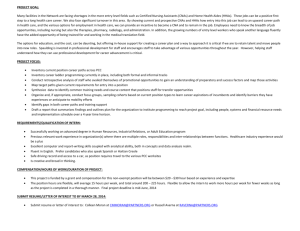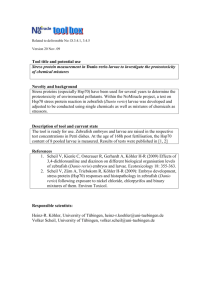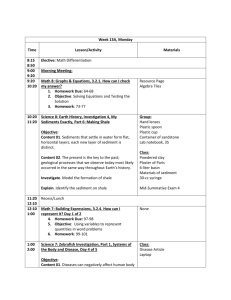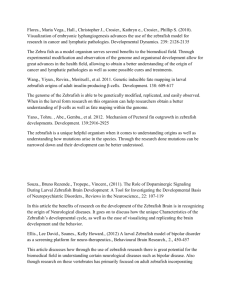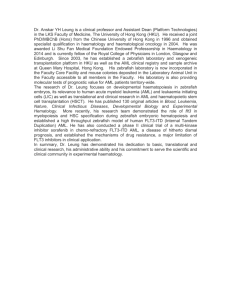Supplemental Methods, Tables, and Figure Legends (doc
advertisement
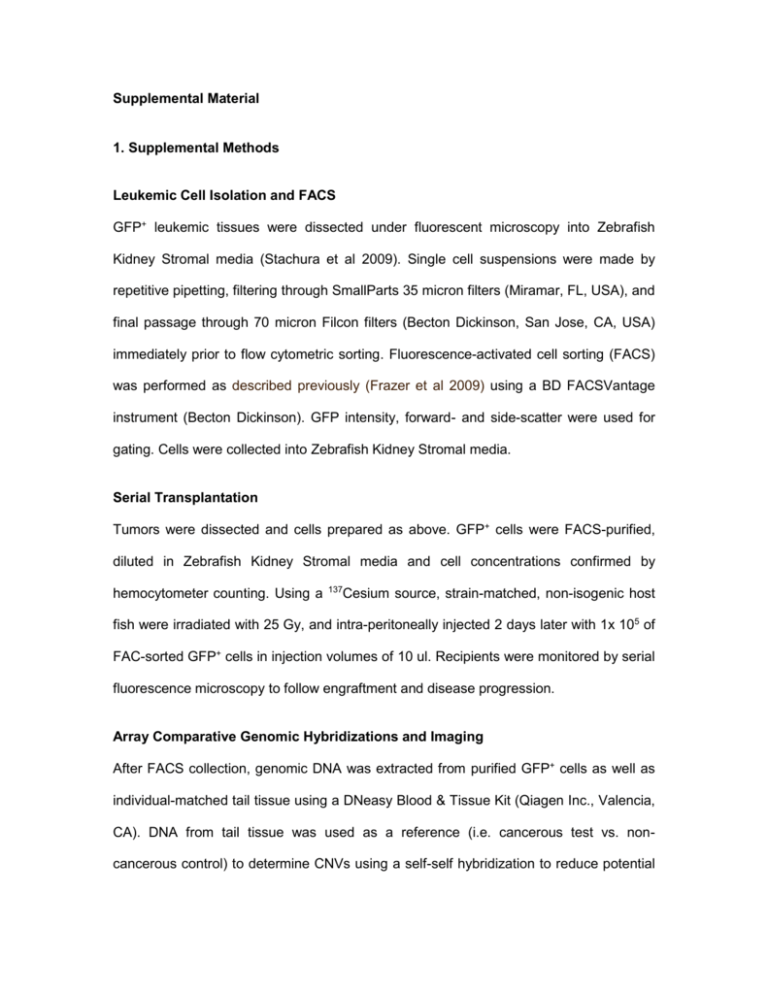
Supplemental Material 1. Supplemental Methods Leukemic Cell Isolation and FACS GFP+ leukemic tissues were dissected under fluorescent microscopy into Zebrafish Kidney Stromal media (Stachura et al 2009). Single cell suspensions were made by repetitive pipetting, filtering through SmallParts 35 micron filters (Miramar, FL, USA), and final passage through 70 micron Filcon filters (Becton Dickinson, San Jose, CA, USA) immediately prior to flow cytometric sorting. Fluorescence-activated cell sorting (FACS) was performed as described previously (Frazer et al 2009) using a BD FACSVantage instrument (Becton Dickinson). GFP intensity, forward- and side-scatter were used for gating. Cells were collected into Zebrafish Kidney Stromal media. Serial Transplantation Tumors were dissected and cells prepared as above. GFP+ cells were FACS-purified, diluted in Zebrafish Kidney Stromal media and cell concentrations confirmed by hemocytometer counting. Using a 137 Cesium source, strain-matched, non-isogenic host fish were irradiated with 25 Gy, and intra-peritoneally injected 2 days later with 1x 105 of FAC-sorted GFP+ cells in injection volumes of 10 ul. Recipients were monitored by serial fluorescence microscopy to follow engraftment and disease progression. Array Comparative Genomic Hybridizations and Imaging After FACS collection, genomic DNA was extracted from purified GFP+ cells as well as individual-matched tail tissue using a DNeasy Blood & Tissue Kit (Qiagen Inc., Valencia, CA). DNA from tail tissue was used as a reference (i.e. cancerous test vs. noncancerous control) to determine CNVs using a self-self hybridization to reduce potential inter-individual effects. After heat denaturation, genomic DNA (500 ng) from the test and reference sample was labeled with Cy5-dCTP or Cy3-dCTP by random priming using the BioPrime Labeling Kit (Invitrogen, Carlsbad, CA), in which fluorescently labeled nucleotides are incorporated during genomic DNA replication. Unincorporated nucleotides were removed with Amicon Ultra 0.5 mL 30K filters (Millipore) prior to determination of DNA concentration and dye incorporation. For array hybridizations, 3.5 μg of labeled tumor DNA was co-precipitated with 3.5 μg of reference DNA at a total volume of 79 μl; 25 μl of herring sperm DNA, 26 μl of blocking agent, and 130 μl of hybridization solution were combined and denatured at 95°C for 3 minutes. Samples were then pre-hybridized at 37°C for 30 minutes before being placed on custom NimbleGen or Agilent zebrafish arrays. Arrays were placed in individual hybridization chambers and hybridized for 40 hours at 65°C. After hybridization, cover slips were removed by placing slides into Oligo aCGH wash buffer I. Slides were then transferred to a second wash solution of Oligo aCGH wash buffer I at room temperature and washed for 3 minutes. After the first wash, slides were transferred to a preheated container of Oligo aCGH wash buffer II at 37°C for 1 minute. Slides were then gently removed from the solution to prevent streaking and placed directly into the scanner for image processing. A two-color scan of the arrays was conducted using an Agilent G2565CA Microarray Scanner System with SureScan High Resolution Technology (Agilent Technologies, Inc., Santa Clara, CA) at a 3 μm resolution. Images were analyzed using Agilent Feature Extraction software which normalizes Cy3 and Cy5 fluorescence intensities across the array and quantifies each DNA probe for color intensities and background intensity to produce Cy3/Cy5 log2 ratios. Array analysis Copy-number analysis using the Rank Segmentation algorithm and group comparisons were performed employing the BioDiscovery Nexus Copy Number 5.0 software (BioDiscovery, El Segundo CA, USA). Copy-number analysis was done using a significance threshold (p- value) of 1x10-6 and a minimum of 3 affected adjacent probes. Thresholds for gains and losses were set such that aneuploidies were detectable, and deletions in the T cell receptor regions were visible in at least 90% of samples. For zebrafish analyses, Nexus-produced CNA calls were refined by removing regions of “self-self” hybridization, regions where >3Mb was amplified or deleted, and areas where CNAs were also present in normal zebrafish T lymphocytes. Sample hlk 1 srk 3 srk 3 otg 1 hlk 4 hlk 4 hlk 4 hlk 4 mMyc Event trisomy trisomy 4 MB amplification trisomy trisomy trisomy trisomy 5 MB amplification trisomy Boundaries chr 6 chr 8 chr23:0-4,075,864 chr 23 chr 6 chr 21 chr 23 chr1:19,044,570-24,073,766 chr 19 A gene list was created first by identifying genes altered in all CNAs from both the NimbleGen and Agilent platforms, and then cross-referencing to Zv6 and Zv8, respectively, to determine current official zebrafish gene names. Each zebrafish gene was then cross-referenced to the NCBI human genome database 36.1 and/or sequencesearched by BLAST to determine homologous human genes. Zebrafish genes with homology to multiple human genes were only counted once. The human gene list was then used to analyze human T-ALL datasets by using the “Query” function of Nexus 5. Human Datasets Two human T-ALL datasets were used. The first dataset includes 47 patients treated on Children’s Oncology Group study P9404 or Dana-Farber Cancer Institute study 00-01 clinical trials. Among these, 25 achieved event free survival, 9 showed induction failure, and 13 eventually relapsed (Gutierrez et al 2010a, Gutierrez et al 2010b). The second dataset contained paired primary and relapse samples from 14 T-ALL patients treated at St Jude Children’s Research Hospital between 1993 and 2005 (Mullighan et al 2007). All 14 patients relapsed, and aCGH data was available from both their primary and relapsed T-ALL samples. Eight of these patients also had non-malignant germline DNA analyzed by aCGH, and any genes with CNAs in these germline samples were excluded from study, as they represent germline CNVs and not somatically-acquired CNAs. 2. Supplemental Tables Supplemental Table 1. CNAs Observed in Zebrafish and Human T-ALLs 17 Zebrafish T-ALLs Total CNAs Amplifications Deletions 176 22.0 (4-68) 117 14.6 (1-54) 210,165 59 7.4 (2-14) 72,810 664 73.8 (28-143) 218 24.2 (7-81) 189,639 446 49.6 (22-105) 143,276 840 49.4 335 19.7 196,808 505 29.7 135,044 Total CNAs Amplifications Deletions Agilent 244K (n=47) average (range) average size (bp) 509 17.8 (9-35) 130 3.4 (0-11) 2,661,949 379 14.4 (9-25) 4,108,918 Affymetrix 500K (n=8) or snp6 (n=20) average (range) average size (bp) 1069 35.3 (3-90) 380 11.6 (0-37) 1,759,019 689 25.1 (3-72) 1,914,300 1578 24.2 510 6.4 1,989,178 1068 18.3 2,693,102 Nimblgen (n=8) average (range) average size (bp) Agilent (n=9) average (range) average size (bp) Summary (n=17) average average size (bp) 75 Human T-ALLs Summary (n=75) average average size (bp) Supplemental Table 2. Zebrafish Primary and Passaged T-ALL CNAs Primary T-ALLs (n=3) Passaged T-ALLs (n=3) Total # of CNAs Average # of CNAs (range) 154 51.3 (31-89) 186 62.0 (28-119) Primary-only CNAs (% of total) Average # of CNAs (range) 69 (45%) 23.0 (15-34) n/a n/a n/a n/a 101 (54%) 33.7 (17-64) 85 (55%) avg. 28.3 (11-55) 85 (46%) avg. 28.3 (11-55) Passaged-only CNAs (% of total) Average # of CNAs (range) Shared Primary and Passaged CNAs Average # of CNAs (range) Supplemental Table 3. Algorithm for Identifying D. rerio CNA Genes with Human Homologues Algorithm Processing Step D. rerio T-ALL CNA Genes NimbleGen platform (8 samples) 311 (+) Agilent platform (9 samples) 759 (=) # of Genes in >1 CNA on either platform 1070 (-) # of Genes present in CNAs on both platforms 127 (=) Total # of unique CNA genes 943 (-) Genes lacking human homologues Genes not located on human genome build 36.1 15 2 (=) D. rerio CNA genes with human homologues 926 (-) Genes with human germline CNVs 33 (=) Analyzable homologous gene pairs 893 Supplemental Table 4. Recurrent CNA genes in D. rerio and Human T-ALLs Shared and recurrent CNA genes in zebrafish (n=14) and human (n=61) primary T-ALLs D. rerio gene col15a1 tgfbr1b lrp6 zgc:158374 osr2 zgc:66488 pus7 matn4 zgc:65779 zgc:77727 # of D. rerio T-ALLs with gene in CNA 5 (35.7%) 5 4 (28.6%) 4 4 4 4 3 (21.4%) 3 3 Human gene COL15A1 TGFBR1 LRP6 MANSC1 OSR2 FBXO43 PUS7 MATN2 RNF170 TOR1A # of human T-ALLs (n=61) with gene in CNA (inc. LOH) # of human EFS T-ALLs (n=25) with gene in CNA (inc. LOH) # of human poor-outcome primary T-ALLs (n=36) with gene in CNA (inc. LOH) 5 (6) 5 (6) 6 (7) 6 (7) 6 (6) 6 (6) 4 (4) 4 (4) 4 (6) 4 (4) 4 (4) 4 (4) 3 (3) 3 (3) 2 (2) 2 (2) 2 (2) 2 (2) 2 (2) 3 (3) 1 (2) 1 (2) 3 (4) 3 (4) 4 (4) 4 (4) 2 (2) 2 (2) 2 (4) 1 (1) Shared and recurrent CNA genes of passaged zebrafish (n=3) and poorest-outcome human (n=23) T-ALLs D. rerio gene zgc:153606 zgc:158222 zgc:114085 flt4 ckmt1 ckmt1 zgc:112384 katnb1 zgc:113984 # of D. rerio T-ALLs with gene in CNA 2 (66.7%) 2 2 2 2 2 2 2 2 Human gene C7orf60 AHCYL2 ERGIC1 FLT4 CKMT1A CKMT1B WBP4 KATNB1 HIST2H3C # of human T-ALLs (n=75) with gene in CNA (inc. LOH) # of human EFS T-ALLs (n=25) with gene in CNA (inc. LOH) # of human poor-outcome T-ALLs (n=50) with gene in CNA (inc. LOH) 7 (7) 6 (7) 6 (7) 6 (7) 0 (5) 0 (5) 2 (2) 3 (3) 0 (1) 1 (1) 1 (1) 1 (1) 1 (1) 0 (0) 0 (0) 0 (0) 1 (1) 0 (0) 6 (6) 5 (6) 5 (6) 5 (6) 0 (5) 0 (5) 2 (2) 2 (2) 0 (1) 3. Supplemental Figure Legends Supplemental Figure 1. Distribution of Zebrafish T-ALLs Analyzed by aCGH Genomic DNA from 17 zebrafish T-ALLs was studied by aCGH. Cancers from 4 D. rerio genetic models were used: hlk (n=6), otg (n=4), srk (n=6), and mMyc (n=1). Neoplasias consisted of 14 primary T-ALLs (hlk n=5, otg n=3, srk n=5, mMyc n=1) and 3 seriallytransplanted T-ALLs (hlk passage #7, otg passage #4, and srk passage #3). Supplemental Figure 2. CNAs are Abundant in Primary Zebrafish T-ALLs (A) Genomic representations of 11 primary zebrafish T-ALLs (3 other primary T-ALLs are shown in Supp. Figure 4) and pooled normal T cells from 25 wild-type fish. Nonmalignant tissue from each fish was also tested by aCGH for signal normalization and to prevent spurious detection of germline copy number variations (CNVs) as somaticallyacquired CNAs. T cells were normalized to pooled non-T cell DNA from the same group of 25 fish. Two arrays were used: NimbleGen 385K (top 8 samples) or Agilent 418K (bottom 3 samples and 6 samples in Supp. Figure 4). Red lines denote deletions; green lines signify amplifications. TCR rearrangement-associated deletions on chromosomes 2 and 17 are marked by black arrows on the normal T cell genome, and were also seen in T-ALL samples. Seven trisomies in 5 T-ALLs are highlighted by asterisks. Graphics were created using Nexus5 Copy Number software. (B) Genomic representations of all 14 primary T-ALLs, now with aCGH data pooled and distributed by chromosome. Samples analyzed with NimbleGen arrays (n=8) are at top; 6 T-ALLs tested using the Agilent platform are shown at bottom (3 passaged T-ALLs are shown in Supp. Figure 4). TCR deletions are denoted by red arrowheads. Red and green lines again correspond to deleted and amplified loci. Lines with greater amplitude represent recurrent CNAs in multiple samples. Supplemental Figure 3. CNAs in Zebrafish and Human T-ALLs Zebrafish (n=17) and human (n=75) T-ALL DNA was hybridized to genomic arrays [for zebrafish: NimbleGen 385K (n=8) or Agilent 418K (n=9); for humans: Agilent 244K (n=47), Affymetrix 500K (n=8), or Affymetrix snp6 (n=20)]. aCGH results were analyzed using Nexus5 Copy Number software. CNAs, amplifications, and deletions per sample are plotted by platform. (a) In zebrafish, 840 total CNAs were detected. Black bars depict mean (NimbleGen 22.0, Agilent 73.8, Total 49.4). Grey whiskers represent standard error of the mean. A total of 335 amplifications (19.7/sample) were seen, with 14.6 gains per sample detected by the NimbleGen array and 24.2 gains/sample detected using the Agilent array. Deletions were also prevalent (n=505; 29.7 per sample), with 7.4/sample and 49.6/sample on NimbleGen and Agilent arrays, respectively. (b) In humans, 1578 total CNAs were detected. Black bars depict mean (Agilent 17.8, Affymetrix 35.3, Total 24.2). Genomic gains (n=510; 6.4 per sample) and losses (n=1068; 18.3 per sample) were also common. Agilent platforms detected 3.4 amplifications/sample and 14.4 deletions/sample. Affymetrix arrays identified 11.6 gains/T-ALL and 25.1 losses/T-ALL. Supplemental Figure 4. Genomes of Primary and Passaged D. rerio T-ALLs Genomic depictions of 3 primary zebrafish T-ALLs paired with the same cancer after several transplant iterations (srk 3rd passage; hlk 7th passage; otg 4th passage). CNAs in pooled normal T cells, including T cell receptor deletions (arrowheads) are shown at bottom. Samples were normalized to non-malignant/non-T cell tissue from matched fish. In all 3 pairs, most CNAs are retained in the passaged T-ALL, demonstrating its clonal relationship to the original cancer. Other figure details are as in Supp. Figure 2a. Supplemental Figure 5. Examples of Primary and Passaged Zebrafish T-ALLs (A) D. rerio lines used in these studies carry an lck::EGFP transgene (Langenau et al 2004), rendering their T cells GFP+. At left, wild type fish is shown. The thymus is GFP+, located posterior and dorsal to the eye. Three panels at right show progression of T cell malignancy in one fish over a 4 week time course. Disease begins as a focal tumor in the thymic region, grows locally, and spreads throughout the fish, including the marrow and peripheral blood (Frazer et al 2009). (B) Fish from 2 iterative transplantation series are shown. In upper left panel, a primary T-ALL (i.e., donor fish) is shown. This fish was sacrificed, dissected, and GFP+ cells captured by FACS. Some primary T-ALL cells were used to prepare DNA for aCGH. Other GFP+ cells were intra-peritoneally injected into irradiated recipients as described in the methods. In the 1st round host, GFP+ cells can be seen at the injection site by day 10 (d10), throughout the abdomen by d20, are widely disseminated by d25, and host death occurred on d35. In later transplant rounds, this same sequence of events follows an accelerated course, as shown in d3, d12, and d17 images on the bottom row. Survival curves depicting results from >100 recipients transplanted with otg, srk, or hlk T-ALLs [Figure 1a and our previous studies (Frazer et al 2009, Rudner et al 2010)] demonstrate the consistency of this experimental finding. Supplemental Figure 6. Expression of Recurrent CNA Genes in Human T-ALL Top 2 rows show expression levels for 2 recurring CNA genes from primary T-ALLs. Each box signifies an individual human primary T-ALL case (n=40). Transcript levels are represented as a heat map, with red indicating high expression. OSR2 was deleted in 4/14 (28.6%) zebrafish primary T-ALLs and seen in CNAs from 6/61 (9.8%) human primary T-ALLs. In 40 human primary cases, 38 samples (95%) had low OSR2 mRNA levels. This suggests OSR2 repression may be common in T-ALL, occurring by either genomic deletion or other mechanisms. For TGFBR1 [deleted in 5/14 (35.7%) of D. rerio primary T-ALLs and found in CNAs from 6/61 (9.8%) human primary T-ALLs], transcript levels were low in 30 cases (75%), intermediate in 7 cases (17.5%), and high in only 3 cases (7.5%). No appreciable skewing is seen between good outcome (n=21) and poor outcome (n=19) cases, as expected for CNA gene candidates identified from primary samples. Bottom row shows expression levels for C7orf60, a gene amplified in 2/3 passaged zebrafish T-ALLs. C7orf60 CNAs were present in 6/50 poor outcome human T-ALLs, but only 1/25 good outcome cases. Consistent with CNA findings, C7orf60 mRNA was low in good outcome cases (1/21 with intermediate-to-high level), but high in several poor outcome cases (2/6 induction failures and 4/13 cases destined to relapse). The 5 samples with highest C7orf60 levels all derive from the poor outcome group. Survival was also poorer in cases with C7orf60 rearrangements (Figure 2c). Expression data is from publicly-accessible sources (Gutierrez et al 2010a, Gutierrez et al 2010b). References for Supplemental Methods, Tables, and Figures Frazer JK, Meeker ND, Rudner L, Bradley DF, Smith AC, Demarest B et al (2009). Heritable T-cell malignancy models established in a zebrafish phenotypic screen. Leukemia 23: 1825-1835. Gutierrez A, Dahlberg SE, Neuberg DS, Zhang J, Grebliunaite R, Sanda T et al (2010a). Absence of biallelic TCRgamma deletion predicts early treatment failure in pediatric Tcell acute lymphoblastic leukemia. J Clin Oncol 28: 3816-3823. Gutierrez A, Sanda T, Ma W, Zhang J, Grebliunaite R, Dahlberg S et al (2010b). Inactivation of LEF1 in T-cell acute lymphoblastic leukemia. Blood 115: 2845-2851. Langenau DM, Ferrando AA, Traver D, Kutok JL, Hezel JP, Kanki JP et al (2004). In vivo tracking of T cell development, ablation, and engraftment in transgenic zebrafish. Proc Natl Acad Sci U S A 101: 7369-7374. Mullighan CG, Goorha S, Radtke I, Miller CB, Coustan-Smith E, Dalton JD et al (2007). Genome-wide analysis of genetic alterations in acute lymphoblastic leukaemia. Nature 446: 758-764. Rudner LA, Frazer JK, Trede NS (2010). Modeling human hematologic malignancies in zebrafish: A review. Current Trends in Immunology. Stachura DL, Reyes JR, Bartunek P, Paw BH, Zon LI, Traver D (2009). Zebrafish kidney stromal cell lines support multilineage hematopoiesis. Blood 114: 279-289.



